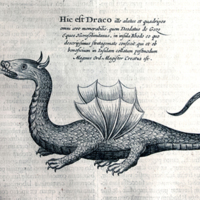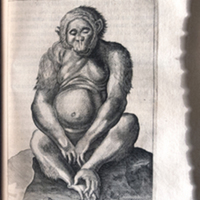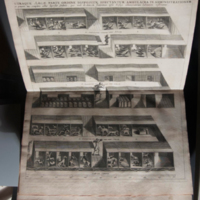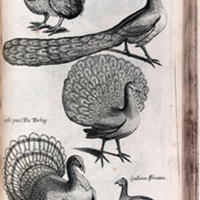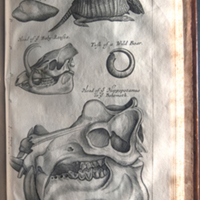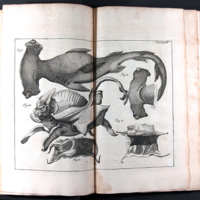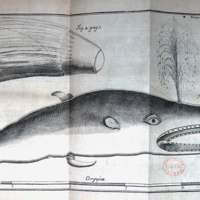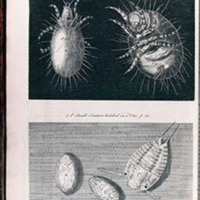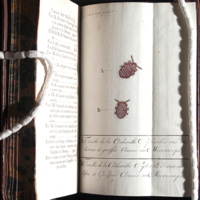Animal II
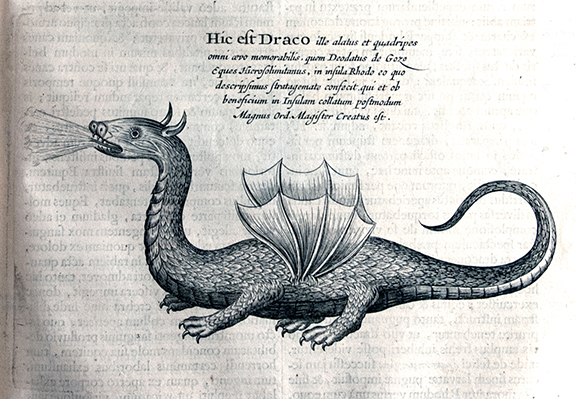
Kircher’s Mundus Subterraneus presented a global natural history, covering basically everything related (even tangentially) to the subterranean parts of the earth. Topics covered included volcanoes, metallurgy, zoology, and fossils. The chapter on cave-dwelling animals includes a section on dragons, which were deemed relevant in that they lived underground. Kircher was certain that dragons were real, and he even identified two different species of dragon: a winged dragon, and a flightless one. Kircher accepted dragons as a reality for several reasons. They were described in Biblical and ancient texts, which he regarded as trustworthy sources. There were also contemporary accounts of supposed sightings of dragons and dragon remains, and Kircher seems to have taken them seriously. Lastly, many museums contained stuffed specimens which were purported to be dragons, some of which Kircher had seen. In reality, these specimens were usually constructed by distorting and altering the carcasses of known species in order to create the illusion of a mythical creature. Kircher did not, though, think that the dragons could breathe fire. He speculated that they might emit some sort of phosphorescence, which was then mistaken for flames.
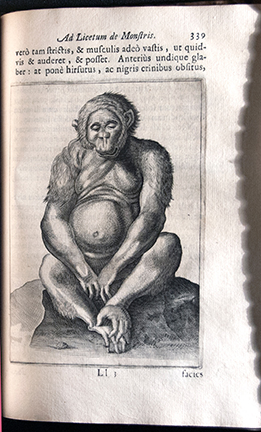
Fortunio Liceti was an Italian doctor, philosopher, and scientist. His De Monstris, first published in 1616, was an important treatise on birth deformities, both human and animal. Liceti’s work was one of the first to provide a classification of mutations based on their morphologies, and he continued to be cited into the nineteenth century. Liceti was also unique for recognizing that anomalies occurred naturally during fetal development, as well for discussing them in a relatively positive light. By contrast, many of his contemporaries believed that any kind of aberration was a sign of divine punishment.
Although the first edition was printed without illustrations, later versions, such as this third printing shown here, were accompanied by seventy engravings depicting a variety of the anomalies covered in the text. Many of them are recognizable as real, biological birth defects, and are rendered so accurately as to suggest that they were likely drawn from specimens. Numerous others, though, are clearly impossible, and include a variety of human-animal hybrids. This edition is also the first printing of De Monstris to include an appendix by Gerard Blasius (1626?-1692) which supplies engravings of fifteen additional deformities. Curiously, classed among them is a very accurate illustration of an orangutan, which is here identified as the “Satyr Indica.” The orangutan was first described in the West in the early seventeenth century, and was thus a fairly new discovery at the time that De Monstris was printed.
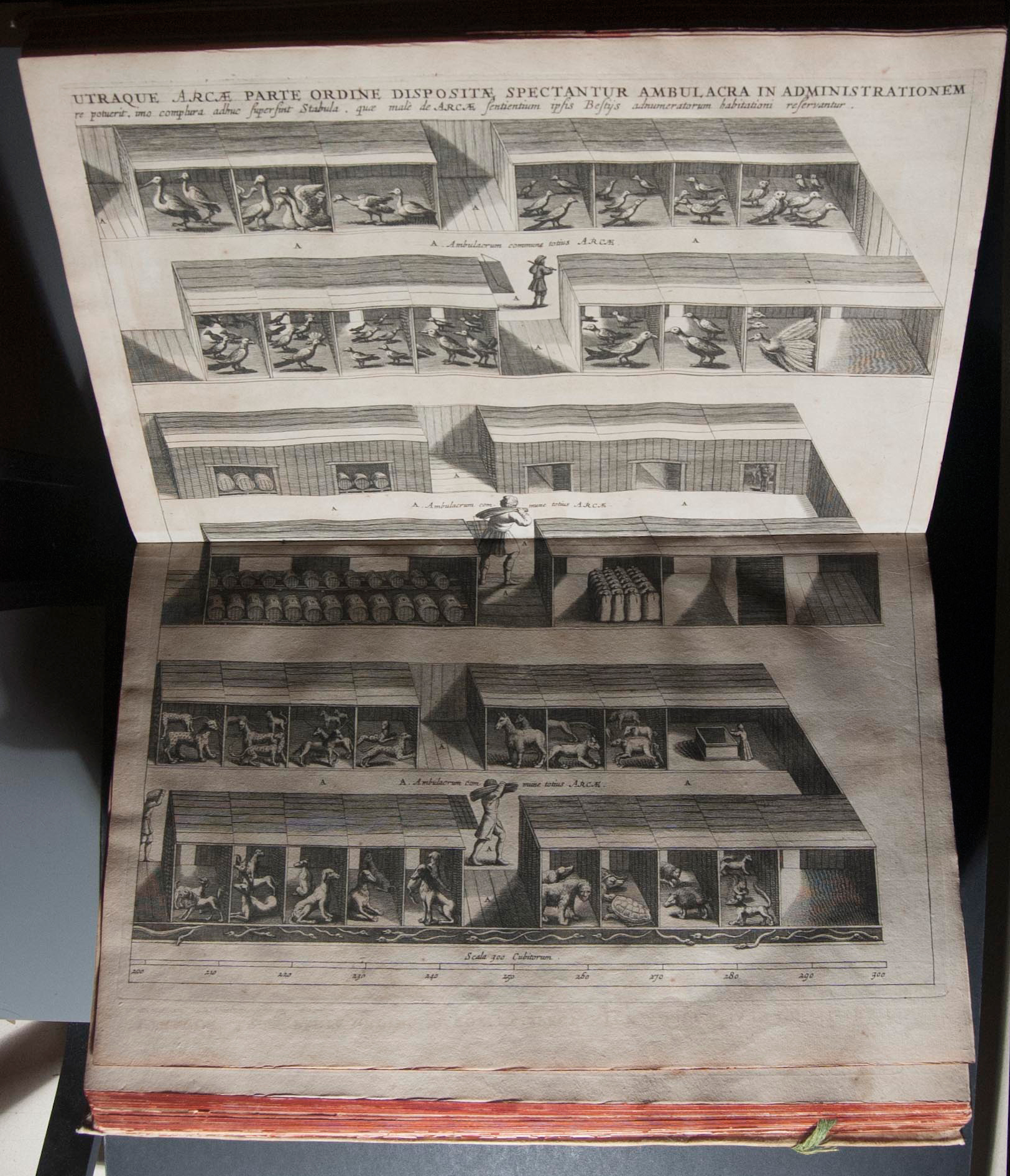
Arca Noë was Kircher’s treatise on the Biblical story of Noah’s ark, an event which Kircher firmly believed was a historical fact. Much of the book was spent trying to prove that the ark was physically possible, in counter to growing skepticism. In making his case for the ark, Kircher provided a detailed, illustrated catalog of all known animals. (He also included a chart showing where they would have lived on the ark). Kircher provided this information in order to establish the necessary size of the ark, but it also is interesting on its own as an example of seventeenth-century zoology. (Absent from Kircher’s bestiary are creatures, such as frogs and lizards, that he believed were produced by spontaneous generation, and which could be expected to reappear on their own after the flood. Also absent are mules and giraffes, which Kircher thought were the product of later interbreeding between different species). Most of the animals depicted by Kircher are real, with the images being relatively accurate. He also included three mythical creatures – the unicorn, the gryphon, and the mermaid – but expressed some doubts about their existence. (The fact that Kircher covered these creatures in the first place gives some indication as to what sort of animals were regarded as plausible possibilities). He was certain that the mermaid existed, but was skeptical of the gryphon. As for the unicorn, Kircher noted that the creature was described in the Bible and in ancient sources, but speculated that they may have actually been describing some form of rhinoceros. Kircher also described the so-called unicorn horns which could be found in many European treasuries, but argued (with some accuracy) that the horns were really derived from a fish (which would actually have been the narwhal, a mammal).
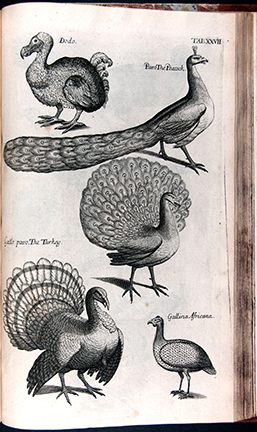
Francis Willughby (1635-1672) was the first ornithologist to present birds in a taxonomy based on anatomical form. Willughby travelled extensively through Europe with his friend, John Ray (1628-1703) to research and observe bird species. Many of their specimens came from city market stalls, where they were being sold for food, meaning that a great many species were only seen in their postmortem state. Willughby planned to visit North America to see additional species, but failing health prevented this. He died leaving his work unfinished. Ray went on to assemble Willughby’s scattered notes and papers, which saw print in Latin in 1676; an English translation (shown here) followed in 1678. (Ray’s role in compiling and writing the text is unclear; he declined to take credit, though he may have actually written much of it.) The book described about 500 species, based both on their observations and on second-hand sources. Though concerned only with external characteristics, Willughby’s classification system represented a marked improvement over previous systems, and did a relatively good job of reflecting real relationships between bird species. This was also the last time that someone tried to print a single volume containing all that could be known about birds.
Shown here is an illustration of the dodo, which was still extant, though their numbers were rapidly dwindling. Willughby describes it as a “slow-paced and stupid bird.” He had seen dried specimens of the bird, but his accounts of it in life are taken at second-hand. The last reliable report of a living dodo was in 1688, and modern estimates place their extinction sometime between 1688 and 1715. Isolated to the island of Mauritius, it rapidly fell prey to Dutch settlers and the invasive species they brought with them. The extinction was not really noticed at the time: the very idea that a species could be exterminated did not yet exist as a concept. When the Dutch abandoned Mauritius in 1710, no one seems to have noticed that the dodo was already gone.
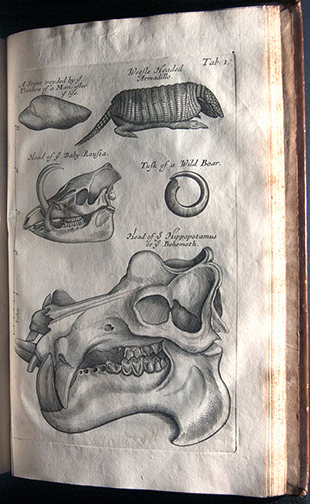
Founded in 1660, the Royal Society of London continues to operate as a learned society devoted to the growth and development of scientific knowledge. From their earliest days, the Society stressed the importantance of science as learned through observations and experiments. Prominent early members included Robert Boyle (1627-1691) and Isaac Newton (1642-1727), and early Society publications included Robert Hooke’s (1635-1703) treatise on microscopes and John Evelyn’s (1620-1706) Sylva. As part of their mission to support scientific research, the Royal Society began assembling a collection of natural history specimens. The Royal Society drew a sharp distinction between earlier cabinets of curiosity and their own collection, which was expressly intended for research and study. Musæum Regalis Societatis, written by Nehemiah Grew (1641-1712), then secretary to the Royal Society, printed an illustrated catalog of the Royal Society’s collections. The catalog attempted to describe each item in the context of an ordered framework. Additionally, Grew compared the Royal Society’s items to those in other museums, allowing one to gain an idea of the overall state of scientific collections of the time. The catalog is broad in scope, covering animals, plants, minerals, and human remains, with significant attention paid to the internal anatomy of the specimens being described. Portions of the Royal Society’s museum have since been incorporated into the British Museum, but many specimens have long since been lost to decay. The printed catalog thus provides the only opportunity to see the Royal Society’s museum as it existed in the seventeenth century.
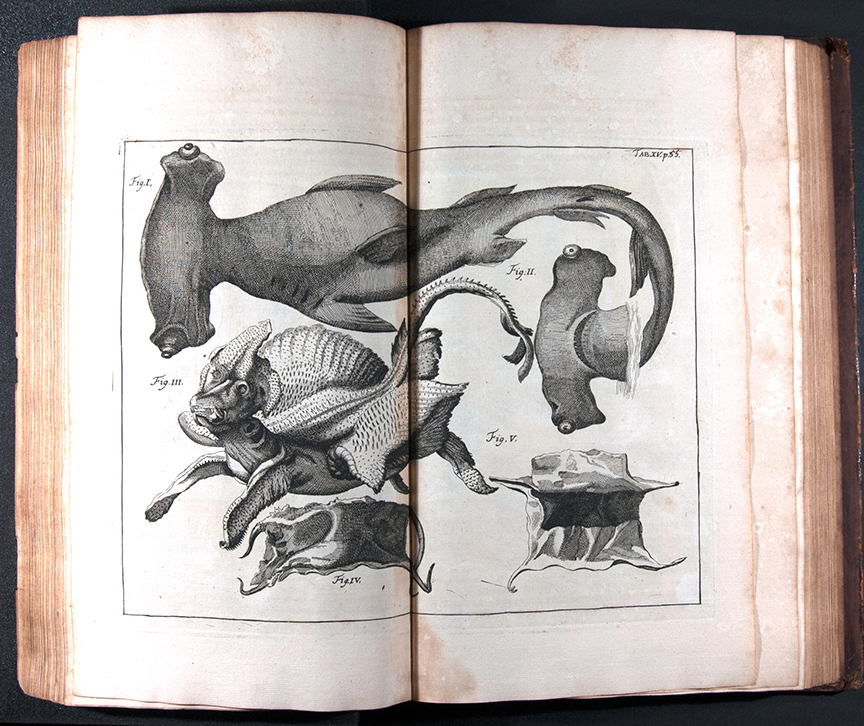
Rariora Mvsei Besleriani prints an illustrated description of a natural history museum that was assembled by Basilius Besler and his nephew, Michael Rupert Besler (1607-1661). Basilius Besler had worked as a pharmacist and was in charge of the bishop’s gardens in Eichstatt. When he relocated to Nuremberg, Besler established his own botanical garden and assembled a vast collection of natural history specimens. After his death, the collection was continued by his nephew, Michael Rupert Besler. Although earlier publications had printed plates depicting select specimens, this book contained the first full printed description of the collection. The plates display a wide variety of biological, horticultural, and mineralogical specimens, some of which have been dissected to show their anatomical structure. For those unable to observe wildlife in their natural habitats, collections such as this provided a valuable resource for the study of natural history.

Now known as the German Academy of Sciences Leopoldina, the Academia Caesarae Leopoldino was founded in Schweinfurt in 1652 with the mission of bringing leading scholars together to explore the natural sciences. Shown here is a volume of the Ephemerides, the journal of the Academia, which was begun in 1670 and was the first medical and scientific journal ever printed. The engraving shown here accompanies a report on a whale that was sighted in 1726. Although crude, the illustration is more or less recognizable, especially as compared to some of the earlier sixteenth and seventeenth century renditions.
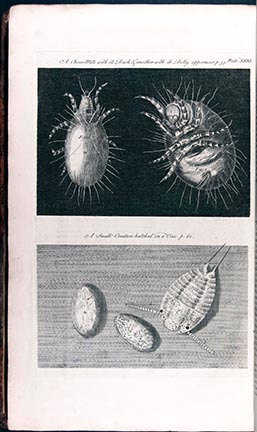
Robert Hooke was an English scientist and natural philosopher whose work spanned a great number of disciplines, including physics, biology, paleontology, and astronomy. His Micrographia, first published in 1665, documented his microscopical experiments and observations. The book was especially renowned for its detailed engravings, which were based on Hooke’s own drawings, and depicted a great number of specimens, both organic and inorganic, including insects, arachnids, bird feathers, plants, feathers, diamonds, and snowflakes, along with manmade objects such as needles and ribbons. These images presented an entirely new vision of a great number of everyday creatures and objects, and helped to make the book widely popular with both the scientific community and the general public. The original text of the Micrographia included a great deal of analysis and conjecture about the origin of microscopic forms, and also often veered into tangential speculations about other aspects of natural philosophy. The volume shown here is a later printing, from 1745, by which time the original editions were already quite rare. With the exception of seven plates that had to be recast based upon the 1665 printing, the illustrations were all printed using Hooke’s original copper-plates. The text, however, was revised and substantially abridged for this edition, as the publisher thought Hooke’s text was “tedious and obscure,” and rife with obsolete science, such as the doctrine of spontaneous generation. (In his preface the publisher complained that Hooke had employed a “verbose and diffused way of writing,” as “was in fashion, which seems to us at present tedious and distasteful.”)
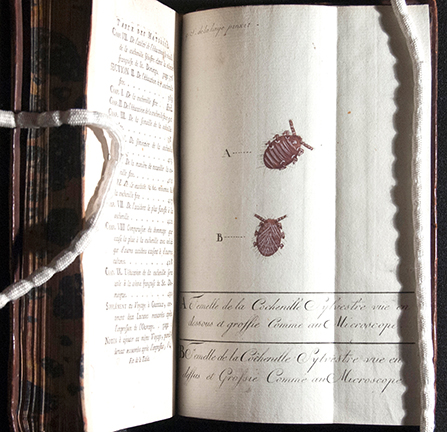
Thiéry de Menonville’s Traité de la Culture du Nopal was a posthumously published account of the production of cochineal-based dye. Cochineal was originally mistaken for a fruit or berry produced by the nopal cactus. After the introduction of the microscope, the “fruit” was correctly identified as a small insect. Cochineal was first cultivated by Aztec farmers, who ground it up to produce red dye. It was subsequently introduced to the European market by the conquistador Hernán Cortés (1485-1547), who observed its production in 1519 and began exporting it to Spain. In order to maintain their monopoly on cochineal dye, the Spanish government carefully controlled the export of cochineal insects and treated the details of their growth and production as a strict trade secret. In the eighteenth century, Thiéry was employed as a spy by the French government, in the hopes that he could learn the secrets of cochineal production and break Spain’s monopoly. To this end he traveled to Mexico disguised as a Catalan physician, where he observed cochineal farming techniques and stole live specimens of the insects, which he took with him to Saint Domingue (present day Haiti) in the hopes of establishing a rival source of cochineal dye production. His efforts proved unsuccessful. Thiéry died of fever three years later, and Spain’s monopoly went unhindered. This posthumous volume was printed to document what Thiéry had learned. The plates include illustrations of the cochineal insect under a microscope. Due to Spain’s tight controls on cochineal production and export, few in Europe would have ever had the chance to see a living cochineal insect.

